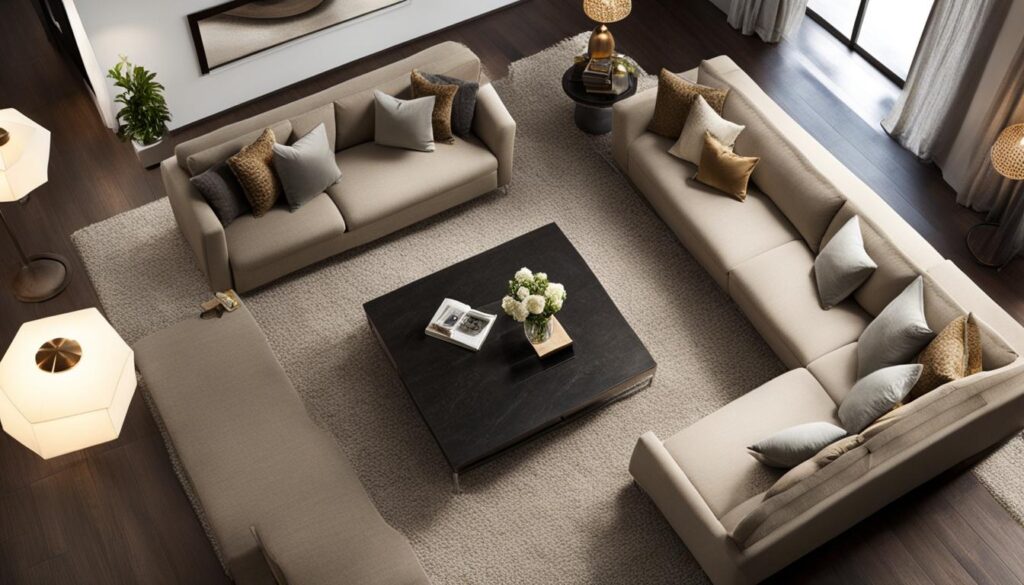When it comes to choosing the right size rug for your living room, there are a few factors to consider. Experts recommend leaving a 12 to 18-inch border between the rug and the walls to create a visually appealing space. The most popular rug size for living rooms is 8′ x 10′, which fits well in average-sized living rooms. However, the ideal rug size for a living room depends on the size of the room itself and the desired mood you want to create.
For smaller living rooms, it’s best to size down on the rug to avoid making the room feel smaller. On the other hand, larger living rooms or open floor plans look great with a larger rug (9ft x 12ft or bigger) to define the living space from other areas in the room.
Key Takeaways:
- Experts recommend leaving a 12 to 18-inch border between the rug and the walls.
- The most popular rug size for living rooms is 8′ x 10′.
- The ideal rug size depends on the size of the room and desired mood.
- Smaller living rooms should opt for a smaller rug to avoid making the room feel smaller.
- Larger living rooms or open floor plans can benefit from a larger rug to define the living space.
Tips for Choosing the Right Rug Size for Your Living Room
When it comes to selecting the perfect rug size for your living room, there are a few key factors to consider. By following these expert tips, you can ensure that the rug you choose fits seamlessly into your space, enhancing both its functionality and aesthetic appeal.
- Measure the area: Start by measuring the space between the rug and the walls. A general rule of thumb is to leave a 12 to 18-inch border, which creates a visually pleasing effect. This border helps to define the area and prevents the rug from overwhelming the room.
- Consider the 70% rule: To create a balanced look, the rug should cover at least 70% of your floor space. This means leaving about 1 to 2 feet of space between the rug and the wall on each side. This rule ensures that the rug anchors the furniture and provides a cohesive foundation for the room.
- Placement: In smaller living rooms, placing the rug under the coffee table can help create a cozy and intimate setting. For larger living spaces, consider placing the rug in a way that allows two or four legs of your sofa and chairs to sit on the rug. This helps to connect the seating area and defines the living space.
Additionally, it’s important to consider the mood you want to create in your living room. A large, oversized rug can contribute to a cozy and relaxed atmosphere, while a smaller rug can give a more formal and defined feel to the space. By keeping these tips in mind and taking into account the size and layout of your living room, you can confidently choose the perfect rug size that enhances your overall decor.
Expert Tip: “Remember that the rug acts as the foundation of your living room, so it’s important to choose the right size that complements the space. Don’t be afraid to experiment and try different rug sizes to find the perfect fit!”
Table: Rug Size Guide for Living Rooms
| Room Size | Ideal Rug Size |
|---|---|
| Small Living Room (8′ x 10′) | 6′ x 9′ |
| Medium Living Room (10′ x 12′) | 8′ x 10′ |
| Large Living Room (12′ x 15′ or bigger) | 9′ x 12′ or larger |
Rug Size Guide for Different Rooms in Your Home
When it comes to choosing the right size rug for different rooms in your home, it’s essential to consider the dimensions and functionality of each space. Here’s a rug size guide to help you make the right decision for various rooms:
Bedroom:
In the bedroom, the rug should cover the sides and end of the bed, creating a cozy and inviting atmosphere. The size of the rug will depend on the bed size. For a king bed, a rug measuring 9′ x 12′ works well, while an 8′ x 10′ rug is ideal for a queen bed. Make sure to leave enough space around the bed to create a balanced and visually pleasing look.
Dining Room:
In the dining room, the rug should extend 2-3 feet from under the table to allow chairs to move in and out easily. This ensures a comfortable dining experience and prevents the chairs from getting caught on the edges of the rug. Common rug sizes for dining rooms include 6′ x 9′, 8′ x 10′, and 9′ x 12′. Choose a size that accommodates your dining table and chairs while still leaving room for movement.
Hallway:
For hallways, the best option is to use a runner rug. A runner rug is a long, narrow rug that is perfect for hallways. It helps to define the space and adds a touch of style. When placing a runner in a hallway, make sure it is centered and does not extend into the entryway. Typical runner rug sizes for hallways are 2’6″ x 7′, 2’6″ x 9′, and 2’6″ x 12′. These sizes are perfect for most standard hallways.
| Room | Ideal Rug Size |
|---|---|
| Living Room | Depends on the size of the room |
| Bedroom | 9′ x 12′ for a king bed, 8′ x 10′ for a queen bed |
| Dining Room | 6′ x 9′, 8′ x 10′, or 9′ x 12′ |
| Hallway | 2’6″ x 7′, 2’6″ x 9′, or 2’6″ x 12′ |
Remember, these are general guidelines, and you can always adjust the rug size based on your personal preferences and the specific layout of your rooms. By selecting the right rug size, you can enhance the functionality and aesthetics of each space in your home.
Conclusion
Selecting the right size rug for your living room is essential for creating a visually appealing and cohesive space. By following these best practices and considering the dimensions of your room, you can determine the correct size for your living room rug.
Remember to leave a 12 to 18-inch border between the rug and the walls, as recommended by experts. This will provide a visually balanced look and help define the living space. Take into account the 70% rule, ensuring that the rug covers at least 70% of your floor space while leaving a small gap between the rug and the wall.
Consider the mood you want to create in your living room. A large, oversized rug can contribute to a cozy and relaxed atmosphere, while a smaller rug can give a more formal and defined feel to the space. Whether you have a small living room or a spacious open floor plan, there is an optimal rug size for every living room.
By carefully selecting the dimensions of your living room rug, you can enhance the overall aesthetic and functionality of your space. So, take the time to measure and choose the right size rug for your living room, and enjoy the transformation it brings to your home.
FAQ
How do I determine the right size rug for my living room?
According to experts, it is recommended to leave a 12 to 18-inch border between the rug and the walls. Measure the area between the rug and the walls to create a visually appealing space. Consider the 70% rule, which suggests that the rug should cover at least 70% of your floor space, leaving 1 to 2 feet on either side between the rug and the wall.
What size rug should I choose for a smaller living room?
For smaller living rooms, it is best to size down on the rug to avoid making the room feel smaller. You can place the rug under the coffee table to anchor the seating area.
What size rug should I choose for a larger living room or open floor plan?
Larger living rooms or open floor plans look great with a larger rug (9ft x 12ft or bigger) to define the living space from other areas in the room. Make sure two or four legs of your sofa and chairs are on the rug to anchor the furniture.
What size rug should I choose for the bedroom?
The rug should cover the sides and end of the bed, providing a warm and cozy feeling. For a king bed, a 9′ x 12′ rug works well, and for a queen bed, an 8′ x 10′ rug is recommended.
What size rug should I choose for the dining room?
The rug should extend 2-3 feet from under the table, allowing chairs to move in and out easily. Common rug sizes for dining rooms are 6′ x 9′, 8′ x 10′, and 9′ x 12′.
What size rug should I choose for hallways?
Runners are the best option for hallways, with the rug centered and not extending into the entryway. Typical sizes for hallway runners are 2’6″ x 7′, 2’6″ x 9′, and 2’6″ x 12′.


